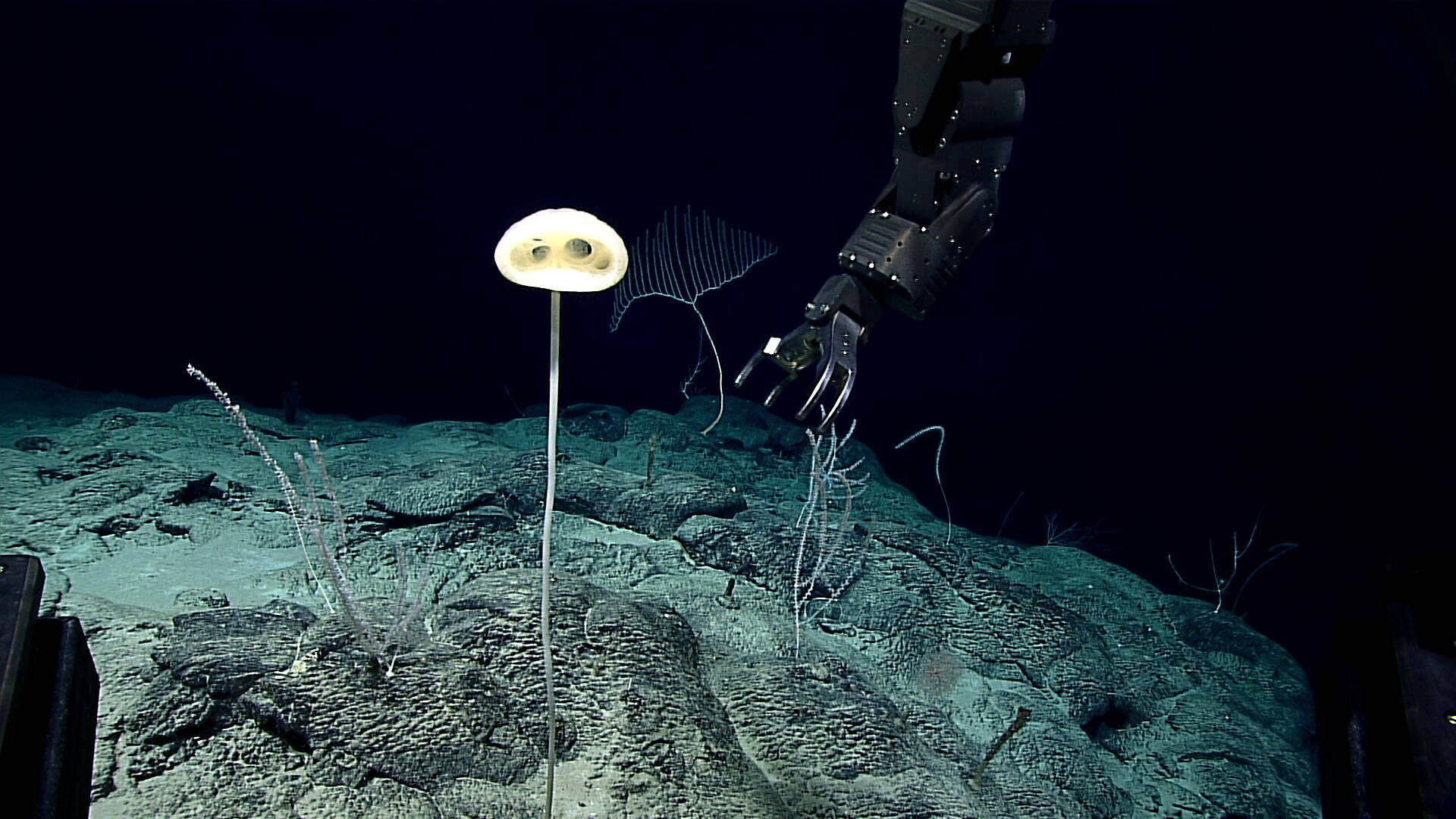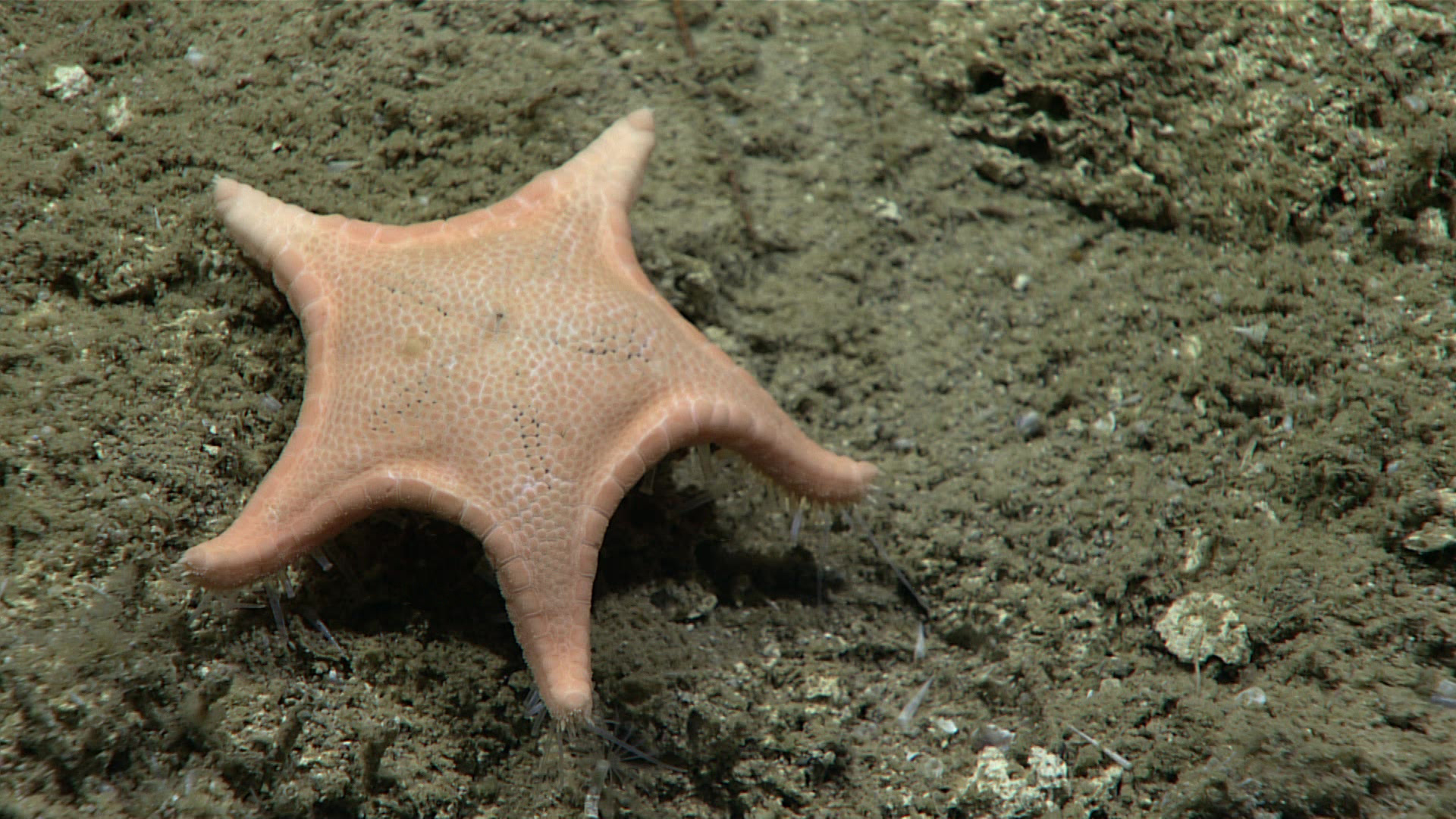Celebrating 20 Years of NOAA Ocean Exploration
Deep-Sea Biological Discoveries
Scientists estimate there may be between 700,000 and 1 million species in the ocean (excluding most microorganisms, of which there are millions). Roughly two-thirds of these species, possibly more, have yet to be discovered or officially described. As we often say, we can’t manage or protect something that we don’t even know exists. So, for the past 20 years, NOAA Ocean Exploration has been contributing to efforts to understand the species that inhabit the deep ocean and the roles they play in their ecosystems and beyond.
It’s not unusual to find a new species, observe a surprising behavior, or see animals in unexpected places or quantities. But it’s always exciting. Every discovery matters, and we value each and every one of them. We’ve highlighted just a few NOAA Ocean Exploration-supported discoveries below.
A Virtual Discovery: Video and Telepresence Enables Designation of New Genus and Species of Comb Jelly
Duobrachium sparksae
In 2015, during a NOAA Ocean Exploration-led expedition in the Atlantic Ocean off Puerto Rico, an unfamiliar comb jelly (ctenophore) caught the attention of scientists participating from shore via telepresence. The sighting pre-dated sampling operations on NOAA Ship Okeanos Explorer, so collection wasn’t an option. Even now, the successful collection of a comb jelly is not a given — they are very delicate and don’t tend to preserve well.
In lieu of a specimen, the scientists used video of the animal captured during the expedition, the only evidence of its existence, to establish that it was indeed new to science. This marked the first time NOAA relied exclusively on video to designate a new genus and species.
Name game: Duobrachium sparksae is Latin for “Sparks’ two-armed ctenophore,” and honors the wife (last name Sparks) of one of the scientists who studied it.
While exploring off Puerto Rico, scientists observed three unfamiliar comb jellies at approximately 3,900 meters (12,795 feet) deep that were different from any known species. After the expedition, scientists used video to formally describe and name the animal: Duobrachium sparksae. Video courtesy of NOAA Ocean Exploration, Océano Profundo 2015.
Learn moreA Magnificent Discovery: An “Alien-Like” Sponge Reminds Us of Other Ocean Worlds
Advhena magnifica
Sometimes we see something that’s been seen before but has yet to be described, named, or collected. This was the case with a distinctive glass sponge seen in 2015 in the waters around Hawai‘i and during the 2016 Deepwater Exploration of the Marianas. Given its appearance, with what resembles a long thin neck, an elongated head, and huge eyes, it earned the nickname E.T. sponge after the beloved alien from the movie E.T. the Extra-Terrestrial.
Fortunately, in 2016, using the manipulator arms and biobox on our remotely operated vehicle Deep Discoverer, the expedition team was able to collect a sample. We saw the E.T. sponge again the following year around Johnston Atoll in what was fondly called the “Forest of the Weird” and in the Musicians Seamounts north of Hawai‘i. In 2020, after years of work, scientists formally described it as both a new genus and a new species. And, the World Register of Marine Species, an authoritative catalog of marine organisms, named it among the top-ten marine species described in 2020.
Name game: Advhena magnifica is Latin for “magnificent alien.” Although E.T. sponge isn’t its official common name, it seems to have stuck.

This E.T. sponge was collected in 2016 at a depth of ~2,000 meters (6,560 feet) in the Pacific Ocean. It has since been formally described and given the name Advhena magnifica (“magnificent alien” in Latin). Image courtesy of NOAA Ocean Exploration, 2016 Deepwater Exploration of the Marianas.
Learn moreA Star is Born: New Sea Star Named for ROV Deep Discoverer
Sibogaster bathyheuretor
A number of sea stars have been discovered as a result of our work on NOAA Ship Okeanos Explorer. This includes sea stars in the Pacific, the Atlantic, and the Gulf of Mexico. But, it’s hard for us not to be partial to one of the more recent discoveries, which was named after our very own remotely operated vehicle (ROV) Deep Discoverer.
During a 2018 expedition in the Gulf of Mexico, one of the most heavily studied areas in U.S. waters, scientists didn’t expect to discover a new sea star. So, they were pleasantly surprised to learn that what they thought was the first sighting of a Sibogaster nieseni in the Gulf of Mexico was actually a new species entirely. Multiple sightings of the new sea star were noted during the expedition, including one that was feeding on a black coral (Bathypathes sp.), the first time such behavior by a sea star was recorded.
Name game: Sibogaster bathyheuretor: The Latin name “bathyheuretor,” derived from Greek, translates to “deep discoverer.”

Named after NOAA Ocean Exploration’s remotely operated vehicle Deep Discoverer, this sea star (Sibogaster bathyheuretor) was seen feeding in the soft, unconsolidated seafloor in the Gulf of Mexico in 2018. Image courtesy of NOAA Ocean Exploration, Gulf of Mexico 2018.
Learn moreAn Unsolved Mystery: Social Media Darling Remains Unknown
Unfortunately, we aren’t able to get answers about every new animal we see on our expeditions. Sometimes a curiosity remains a mystery, making it all the more intriguing.
At the beginning of the first dive of the 2016 Hohonu Moana expedition in the deep waters of Hawaii, we spotted a small, ghost-like octopod that had never been seen before. Observed at a depth of 4,290 meters (14,075 feet), this was also the deepest sighting of this type of octopod (incirrate octopod), to date.
While the primary purpose of the dive was to collect geological data, this animal stole the show. Our followers on social media were quick to note its resemblance to Casper the friendly cartoon ghost, so Casper it became, informally at least. Casper generated a lot of interest from traditional and social media, but until scientists are able to formally describe it, its story will remain largely untold.
Casper, the ghost-like octopod, became a social media celebrity after it was seen for the first time during a dive in the deep waters of Hawai‘i. Scientists believe it represents a new species, and possibly a new genus, of octopod. Video courtesy of NOAA Ocean Exploration, 2016 Hohonu Moana.
Learn moreA Never-Ending Discovery: Deep-Sea Coral Province Continues to Surprise
Some discoveries build on each other over time to create an even more significant discovery. Although first detected and observed several decades ago, a deep-sea coral ecosystem on the Blake Plateau off the U.S. southeastern coast remained relatively unexplored and unknown, until recently.
In the last decade, over multiple mapping and remotely operated vehicle expeditions, NOAA Ocean Exploration and partner scientists have documented mounds of extensive, dense populations of the deep-sea, reef-building coral Lophelia pertusa — some in areas previously believed to be flat and featureless. Ranging in height from 10-80 meters (33-263 feet), these mounds have been growing for thousands, perhaps millions, of years and provide shelter and habitat to a variety of marine life, including sponges, shrimp, crabs, and commercially important fish species.
Now, at 28,047 square kilometers (10,829 square miles), this area is considered to be the largest known deep-sea coral province in U.S. waters, possibly the world. And we’re not done exploring it.
After mapping data collected in 2018 suggested the presence of deep-sea coral mounds, NOAA Ocean Exploration returned to the area in 2019 and encountered this “coral highway” of vast, dense fields of Lophelia pertusa coral. Video courtesy of NOAA Ocean Exploration, Windows to the Deep 2019.
Learn moreThese discoveries all resulted from NOAA Ocean Exploration-led expeditions on NOAA Ship Okeanos Explorer. However, we depend on scientists (often taxonomists) to use the data we collect (samples, video, etc.) to determine the significance of a discovery and, when appropriate, to name and describe new species. NOAA Ocean Exploration also provides support, like grants, to other exploration activities that have also contributed to the growing catalog of marine animals. Among the other animals we have helped add to the taxonomic ranks are fish, corals, jellyfish, sponges, sea stars, shrimp, amphipods, snails, clams, and worms.
Who knows what the next 20 years will bring. Join us on the journey.

